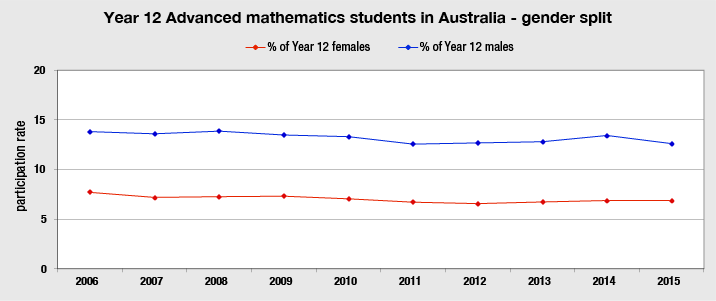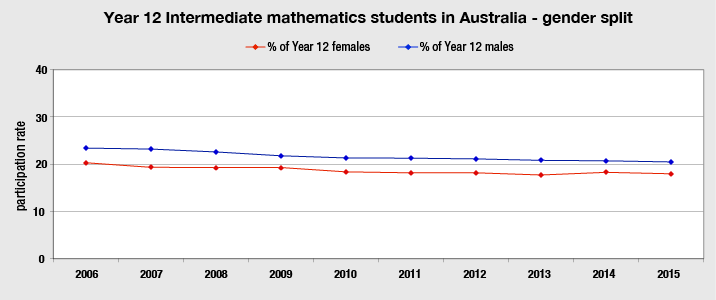This summary for the ten years 2006 to 2015 inclusive is of all Year 12 mathematics students enrolled through the secondary boards of studies in the six states (NSW, VIC, QLD, WA, SA, and TAS) and in the two territories (ACT and NT) together with Australian IBO (International Baccalaureate) students.

Download PDF of Year 12 mathematics students in Australia – last ten years
The spikes in the Advanced and Intermediate mathematics participation rates in 2014 were partly due to the “half cohort”
in WA that year. For 2015, both the Advanced and Intermediate mathematics participation rates reverted to the 2013 levels.
ADVANCED MATHEMATICS STUDENTS:
The NUMBER of Australian Advanced mathematics students in 2015 was higher than in any of the previous nine years:
| Year: | 2006 | 2007 | 2008 | 2009 | 2010 | 2011 | 2012 | 2013 | 2014 | 2015 |
| Number of Advanced maths students: | 20918 | 20284 | 20903 | 21090 | 21306 | 20422 | 20617 | 21189 | 21507 | 21665 |

Download PDF of Year 12 advanced mathematics students in Australia – gender split
Setting aside the slightly unusual 2014 enrolment situation, the girls’ Advanced mathematics participation rate of 6.9% in 2015 is up from 6.7% in 2013, while the boys’ rate is down to 12.6% in 2015 from 12.8% in 2013.
The overall Advanced mathematics participation rate of 9.6% for 2015 is slightly less than the arithmetic mean of the female (6.9%) and male (12.6%) rates, the reason being that females outnumber males in Year 12.
INTERMEDIATE MATHEMATICS STUDENTS:
Most Australian Advanced mathematics students are also enrolled in an Intermediate mathematics subject, and in 2015, the total Intermediate mathematics ENROLMENT was over 60,000. An Intermediate mathematics STUDENT is one who is enrolled in an Intermediate mathematics subject but NOT enrolled in an Advanced mathematics subject.
The NUMBER of Australian Intermediate mathematics STUDENTS in 2015 was higher than in any of the previous nine years:
| Year: | 2006 | 2007 | 2008 | 2009 | 2010 | 2011 | 2012 | 2013 | 2014 | 2015 |
| Number of Intermediate maths students: | 43076 | 42095 | 42174 | 42249 | 42070 | 42307 | 42605 | 42232 | 41756 | 43106 |

Download PDF of Year 12 intermediate students mathematics in Australia – gender split
Again setting aside the slightly unusual 2014 enrolment situation, the girls’ Intermediate mathematics participation rate
of 18.0% in 2015 is up from 17.7% in 2013, while the boys’ rate is down to 20.5% in 2015 from 20.8% in 2013.
ELEMENTARY MATHEMATICS STUDENTS:
Elementary mathematics STUDENTS are those enrolled in one or more Elementary mathematics subjects
but NOT enrolled in an Intermediate mathematics subject NOR in an Advanced mathematics subject.
We estimate the female Elementary mathematics participation rate for 2015 to be a little over 51% and the male rate to be a little under 53%, for an overall rate of 52%. However, in 2015 the NUMBER of female Elementary mathematics students (approximately 59,500) clearly exceeded the NUMBER of males (approximately 57,500).
THE AUSTRALIAN CURRICULUM:
The secondary boards of studies in the six states and two territories are in the process of changing course structures, syllabi and subject names. At this time, some of these eight jurisdictions are already offering Year 12 mathematics courses which comply with the intent of the Australian Curriculum, and in the others there is much ongoing developmental work in progress.
FUTURE TEN-YEAR UPDATES:
With the introduction of the Australian Curriculum, our next ten-year update may need to be in a slightly different format, perhaps reporting participation in the FOUR categories of the Australian Curriculum, namely “Specialist Mathematics” (Advanced mathematics), “Mathematical Methods” (Intermediate mathematics), “General Mathematics” and
“Essential Mathematics”, rather than in the three categories used thus far in our reports.
ACCURACY MATTERS: Advanced and Intermediate participation rates are quoted to the nearest 0.1%.
This year, in our records some small retrospective adjustments have been made to the total number of Australian Year 12 students for 2012, 2013 and 2014, following advice from some of the secondary boards of studies. Consequently for example, the 2012 Advanced mathematics participation rate of 9.4% (previously quoted) has been amended to 9.5%, while the Advanced mathematics participation rates for 2013 and 2014 did not require amendment, remaining correct to the nearest 0.1%. The graphs are not visibly altered.
Frank Barrington
f.barrington@ms.unimelb.edu.au
Michael Evans
michael@amsi.org.au



